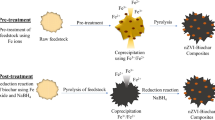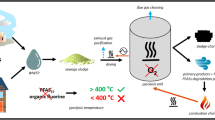Abstract
Humic substance (HS) is the determining factor in controlling the geochemistry behavior and progress of heavy metals. Using fulvic acid (FA) extracted from natural sediment as sorbent, this work studied binding characteristics between FA and Pb2+ considering the influences of temperature, ionic strength and FA concentrations. The results showed the amount of bound-Pb increased with increasing initial Pb2+ concentrations and FA concentrations, but decreased with increasing ionic strengths. Correspondingly, the logarithm conditional distribution coefficients (log K D) of bound-Pb sharply declined as the increase of initial Pb2+, and log K D increase accompanied the increase of FA concentrations and decrease with the ionic strengths. The two-site ligand binding model fit all the binding experimental data very well and proved that two classes of binding sites were involved in the interaction of Pb2+ with the extracted FA. The results clearly confirmed the chemical heterogeneity of the binding sites present in the FA extracted from the lake sediment. Fourier transform infrared spectra indicated that two types of functional groups exist in the extracted FA and participated in the interaction of FA and Pb2+, corresponding to the two-site ligand binding model in description of the characteristics of Pb2+–FA complex. The apparent stability constant (K S) values calculated for the strong binding sites (S1) were higher than for the weak sites (S2) by 1–2 orders of magnitude; however, S1 sites were limited in numbers, as evidenced by lowering the maximum binding capability (B max) values, which were 3–40 times smaller than those for S2 sites. The bound process of Pb2+ to FA is spontaneous and exothermic from the result of the thermodynamic parameters. This work is important to reveal the mechanism of binding characteristics between Pb2+ and FA. It also gives a theoretical and practical direction to understanding the environmental effect of HS, environmental geochemical behavior and bio-availability of heavy metals in lakes.







Similar content being viewed by others
References
Abbt-Braun G, Lankes U, Frimmel FH (2004) Structural characterization of aquatic humic substances—the need for a multiple method approach. Aquat Sci 66:151–170
Aiken GR, McKnight DM, Wershaw RL, MacCarthy P (1985) Humic substances in soil, sediment, and water: geochemistry, isolation and characterization. Wiley, New York
Akar D, Shahwan T, Eroglu A (2005) Kinetic and thermodynamic investigations of strontium ions retention by natural kaolinite and clinoptilolite minerals. Radiochim Acta 93:477–485
Anđelković T, Nikolić R, Bojić A, Anđelković D, Nikolić G (2010) Binding of cadmium to soil humic acid as a function of carboxyl group content. Maced J Chem Chem Eng 29:215–224
Benedetti MF, Milne CJ, Kinniburgh DG, Van Riemsdijk WH, Koopal LK (1995) Metal ion binding to humic substances: application of the non-ideal competitive adsorption model. Environ Sci Technol 29:446–457
Bonten LTC, Groenenberg JE, Weng L, Riemsdijk WHV (2008) Use of speciation and complexation models to estimate heavy metal sorption in soils. Geoderma 146(1):303–310
Buffle J (1988) Complexation reactions in aquatic systems. An analytical approach
Buschmann J, Kappeler A, Lindauer U, Kistler D, Berg M, Sigg L (2006) Arsenite and arsenate binding to dissolved humic acids: influence of pH, type of humic acid, and aluminum. Environ Sci Technol 40:6015–6020
Carbonaro RF, Atalay YB, Di Toro DM (2011) Linear free energy relationships for metal–ligand complexation: bidentate binding to negatively-charged oxygen donor atoms. Geochim Cosmochim Acta 75:2499–2511
Chakraborty P, Manek A, Niyogi S, Hudson J (2014) Determination of dynamic metal complexes and their diffusion coefficients in the presence of different humic substances by combining two analytical techniques. Anal Lett 47:1224–1241
Christl I, Kretzschmar R (2001) Relating ion binding by fulvic and humic acids to chemical composition and molecular size. 1. Proton binding. Environ Sci Technol 35:2505–2511
Christl I, Metzger A, Heidmann I, Kretzschmar R (2005) Effect of humic and fulvic acid concentrations and ionic strength on copper and lead binding. Environ Sci Technol 39:5319–5326
Evangelou V, Marsi M, Chappell M (2002) Potentiometric–spectroscopic evaluation of metal-ion complexes by humic fractions extracted from corn tissue. Spectrochim Acta Part A Mol Biomol Spectrosc 58:2159–2175
Fakour H, Lin T-F (2014) Experimental determination and modeling of arsenic complexation with humic and fulvic acids. J Hazard Mater 279:569–578
Geyer W, Brüggemann L, Hanschmann G (1998) Prediction of properties of soil humic substances from FTIR spectra using partial least squares regression. Int J Environ Anal Chem 71:181–193
Giovanela M, Parlanti E, Soriano-Sierra E, Soldi M, Sierra M (2004) Elemental compositions, FT-IR spectra and thermal behavior of sedimentary fulvic and humic acids from aquatic and terrestrial environments. Geochem J 38:255–264
Gondar D, López R, Fiol S, Antelo J, Arce F (2006) Cadmium, lead, and copper binding to humic acid and fulvic acid extracted from an ombrotrophic peat bog. Geoderma 135:196–203
Guardado I, Urrutia O, Garcia-Mina JM (2005) Methodological approach to the study of the formation and physicochemical properties of phosphate-metal-humic complexes in solution. J Agric Food Chem 53:8673–8678
Gustafsson JP, Persson I, Oromieh AG, van Schaik JW, Sjöstedt C, Kleja DB (2014) Chromium (III) complexation to natural organic matter: mechanisms and modeling. Environ Sci Technol 48:1753–1761
Haiber S, Herzog H, Burba P, Gosciniak B, Lambert J (2001) Two-dimensional NMR studies of size fractionated Suwannee River fulvic and humic acid reference. Environ Sci Technol 35:4289–4294
Heidmann I, Christl I, Kretzschmar R (2005) Aggregation kinetics of kaolinite-fulvic acid colloids as affected by the sorption of Cu and Pb. Environ Sci Technol 39:807–813
Herrero A, Barrado E, Rey F, Machado A (2000) Influence of the ligand concentration and pH on the complexation of Cu (II) by a soil fulvic acid. Analusis 28:127–131
Kinniburgh DG, Milne CJ, Benedetti MF, Pinheiro JP, Filius J, Koopal LK, Van Riemsdijk WH (1996) Metal ion binding by humic acid: application of the NICA-Donnan model. Environ Sci Technol 30:1687–1698
Koopal LK, Saito T, Pinheiro JP, Riemsdijk WHV (2005) Ion binding to natural organic matter: general considerations and the NICA-Donnan model. Colloids Surf, A 265:40–54
Lee MH, Choi SY, Chung KH, Moon H (1993) Complexation of Cadmium (II) with humic acids: effects of pH and humic acid origin. Bull Korean Chem Soc 14:727
Levy JL, Zhang H, Davison W, Galceran J, Puy J (2012) Kinetic signatures of metals in the presence of Suwannee River fulvic acid. Environ Sci Technol 46:3335–3342
Liu G, Cai Y (2010) Complexation of arsenite with dissolved organic matter: conditional distribution coefficients and apparent stability constants. Chemosphere 81:890–896
Lu X, Hanna J, Johnson W (2000) Source indicators of humic substances: an elemental composition, solid state 13 C CP/MAS NMR and Py-GC/MS study. Appl Geochem 15:1019–1033
Milne CJ, Kinniburgh DG, Tipping E (2001) Generic NICA-Donnan Model Parameters for Proton Binding by Humic Substances. Environ Sci Technol 35:2049–2059
Milne CJ, Kinniburgh DG, Riemsdijk WH, Van Edward T (2003) Generic NICA-Donnan model parameters for metal-ion binding by humic substances. Environ Sci Technol 37:958–971
Nakamoto K (1997) Infrared and Raman spectra of inorganic and coordination compounds. Wiley, New York
Nakamoto K, McCarthy PJ (1968) Spectroscopy and structure of metal chelate compounds. Wiley, New York
Otto WH, Carper WR, Larive CK (2001) Measurement of cadmium (II) and calcium (II) complexation by fulvic acids using 113Cd NMR. Environ Sci Technol 35:1463–1468
Patricia M, Sandrine H, Koopal LK (2006) Modeling metal-particle interactions with an emphasis on natural organic matter. Environ Sci Technol 40:7459–7466
Pinheiro J, Mota A, Benedetti M (1999) Lead and calcium binding to fulvic acids: salt effect and competition. Environ Sci Technol 33:3398–3404
Pinheiro J, Mota A, Benedetti M (2000) Effect of aluminum competition on lead and cadmium binding to humic acids at variable ionic strength. Environ Sci Technol 34:5137–5143
Reemtsma T, These A, Springer A, Linscheid M (2006) Fulvic acids as transition state of organic matter: indications from high resolution mass spectrometry. Environ Sci Technol 40:5839–5845
Riggle J, von Wandruszka R (2005) Binding of inorganic phosphate to dissolved metal humates. Talanta 66:372–375
Ritchie JD, Perdue EM (2003) Proton-binding study of standard and reference fulvic acids, humic acids, and natural organic matter. Geochim Cosmochim Acta 67:85–96
Schnitzer M, Gupta UC (1965) Determination of acidity in soil organic matter. Soil Sci Soc Am J 29:274–277
Shaker AM, Komy ZR, Heggy SE, El-Sayed ME (2012) Kinetic study for adsorption humic acid on soil minerals. J Phys Chem A 116:10889–10896
Slaveykova VI, Wilkinson KJ, Ceresa A, Pretsch E (2003) Role of fulvic acid on lead bioaccumulation by Chlorella kesslerii. Environ Sci Technol 37:1114–1121
Stevenson FJ (1994) Humus chemistry: genesis, composition, reactions. Wiley, New York
Tan W, Xiong J, Li Y, Wang M, Weng L, Koopal LK (2013) Proton binding to soil humic and fulvic acids: experiments and NICA-Donnan modeling. Colloids Surf A 436:1152–1158
Tipping E, Hurley MA (1992) A unifying model of cation binding by humic substances. Geochim Cosmochim Acta 56:3627–3641
Wang C, Wang Z, Peng A, Hou J, Xin W (1996) Interaction between fulvic acids of different origins and active oxygen radicals. Sci China Ser C Life Sci/Chin Acad Sci 39:267–275
Warwick P, Inam E, Evans N (2005) Arsenic’s interaction with humic acid. Environ Chem 2:119–124
Weng L, Temminghoff EJ, Van Riemsdijk WH (2001) Contribution of individual sorbents to the control of heavy metal activity in sandy soil. Environ Sci Technol 35:4436–4443
Xia K, Bleam W, Helmke PA (1997) Studies of the nature of Cu2+ and Pb2+ binding sites in soil humic substances using X-ray absorption spectroscopy. Geochimica Et Cosmochimica Acta 61:2211–2221
Xiong J et al (2013) Lead binding to soil fulvic and humic acids: nICA-Donnan modeling and XAFS spectroscopy. Environ Sci Technol 47:11634–11642
Yang Y, Shu L, Wang X, Xing B, Tao S (2011) Impact of de-ashing humic acid and humin on organic matter structural properties and sorption mechanisms of phenanthrene. Environ Sci Technol 45:3996–4002
Yates LM, Von Wandruszka R (1999) Decontamination of polluted water by treatment with a crude humic acid blend. Environ Sci Technol 33:2076–2080
Yu S, Chen C, Chang P, Wang T, Lu S, Wang X (2008) Adsorption of Th(IV) onto Al-pillared rectorite: effect of pH, ionic strength, temperature, soil humic acid and fulvic acid. Appl Clay Sci 38:219–226
Zhang J, Dai J, Wang R, Li F, Wang W (2009) Adsorption and desorption of divalent mercury (Hg 2 +) on humic acids and fulvic acids extracted from typical soils in China. Colloids Surf A 335:194–201
Acknowledgments
This work was supported by National Natural Science Foundation of China (41163006, 41003049) and Inner Mongolia Natural Science Foundation (2015MS0407).
Author information
Authors and Affiliations
Corresponding authors
Rights and permissions
About this article
Cite this article
Wang, J., Lü, C., He, J. et al. Binding characteristics of Pb2+ to natural fulvic acid extracted from the sediments in Lake Wuliangsuhai, Inner Mongolia plateau, P. R. China. Environ Earth Sci 75, 768 (2016). https://doi.org/10.1007/s12665-016-5608-3
Received:
Accepted:
Published:
DOI: https://doi.org/10.1007/s12665-016-5608-3




